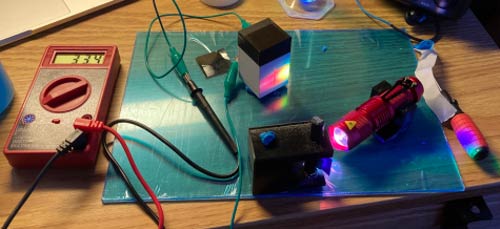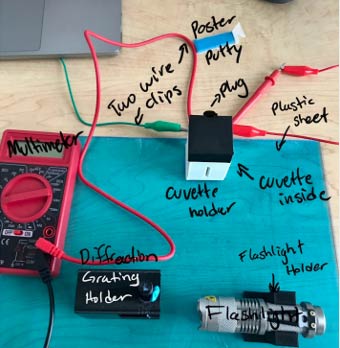DIY Instruments
Danielle Cass, Chemistry
It was summer 2020 and I was faced with a semester, possibly a year, of conducting chemistry labs from the “comfort” (I have three kids) of my house. Besides all of the other things haunting my dreams at night, the question of how the integrity of the chemistry labs would be maintained while providing a safe and affordable at-home option kept creeping in.
There are two tricky things with chemistry labs. First, not all of the chemicals used are safe for disposal in a kitchen sink and second, students learn to use instruments that are costly and non-transportable. The chemical safety can be dealt with by using “kitchen chemistry” options such as food coloring, baking soda, vinegar, etc. However, the instrument issue was a conundrum.
This is where I was thankful for Reed student projects, because a student many years ago had attempted to make their own UV/VIS Spectrophotometer (one of those instruments we use in CHEM 101 that has a price tag of ~$10,000) using Legos and other simplified materials. So I began to scour the internet/literature and came across the work by Chris Stewart and John Giannini1. They provided a layout for how to make a UV/VIS spectrophotometer using 3D printed parts and some wise purchases off Amazon for under $50.
With some serious help from Jay Ewing and the machine shop 3D printer, we were able to print off enough parts to outfit each student with the material to make their own spectrophotometer from their room (Figure 1). The pieces came with the rest of their CHEM 101 kit and were used multiple times throughout the year.


So did we just print off a bunch of plastic pieces to use for one year and then store in a closet collecting dust? No. It turns out that having students make their own spectrophotometer adds to their learning experience in a way we had not done in the past. The spectrophotometers in the lab, although more stable and reproducible, also are a black box of components. Students push a button and the instrument spits out numbers to them. The result is that students often don’t understand how the instrument works. But when forced to make an instrument from scratch they have a new appreciation for what is happening under the hood of the instrument. Therefore students in the fall of 2021 will also get the opportunity to make their own spectrophotometers.
1 Stewart, C.; Giannini, J. Inexpensive, open source spectrometers that use part of a CD or DVD as a diffraction grating. http://pages.stolaf.edu/opn-lab/equipment/ (accessed June 2020).